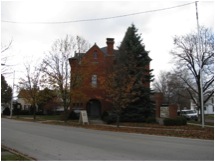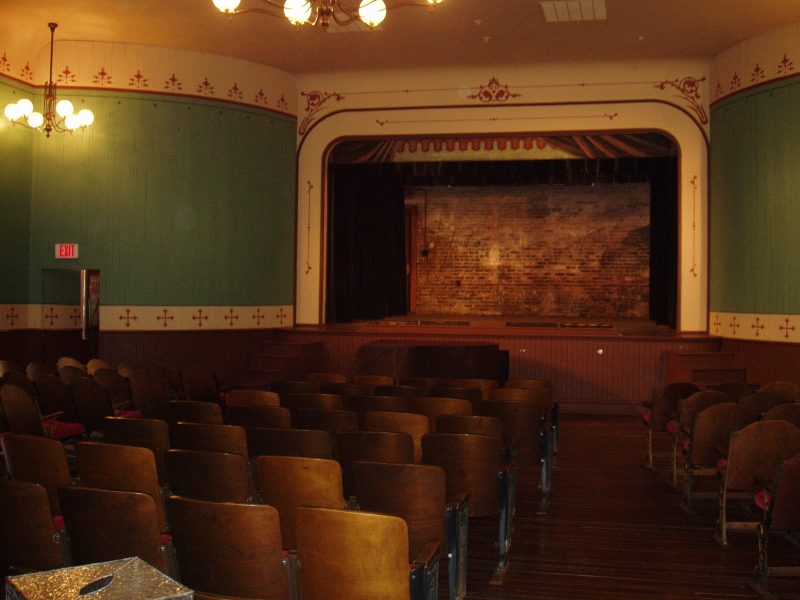Pemberville

Current Name of Theater: Pemberville Opera House
Current Type: Opera House
Seats:
Web site: www.pembervilleoperahouse.org/
Historic Names of Theater:
Address 115 Main Street, Pemberville, OH 43450
Year Built/ Style: 1891
Original Architect:
Original Cost: $6000
Listed on National Register: No
History of Theater:
It was the idea of the civic leaders of the time to build a Town Hall that could be used and enjoyed by all Pemberville citizens. In 1891, during the height of the Oil Boom, construction began on a Town Hall with its’ own Opera House on the second floor. completed at a cost under $6,000. on July 5, 1892, the Opera House boasted folding seats for 250 people as well as a “modern stage” for its’ time. There were two trap doors, one on the stage and one leading to the scenery attic, as well as three dressing rooms. The Opera House functioned with a “raked stage” designed for point-of-perspective view, and Old-English style scenery. Scenes were made by sliding a series of flats into wooden grooves suspended from the ceiling; one scene was slid into view while another was removed. Hand-painted Roll-Drops were also used to create large, picturesque scenes. A small ticket booth was located under the stairs and public opinion remained that the Opera House be self-supportive from the start.

Performances featured local talent and professional entertainers/tours and included concerts, medicine shows, operettas and old fashioned vaudeville routines. It is widely known that the 1890’s fostered the greatest use of the Opera House.
In addition to theatrical/musical entertainment, the “house” was even turned into a basketball court. The first basketball game was played on October 17, 1910 and at one point, crowes were so large that local leaders discussed adding a balcony to the space.
Throughout the 1920’s and 30’s the popular Opera House hosted dances, concerts, lectures, political meetings, socials. husking bees, graduation ceremonies, Boy Scout meetings, class plays and holiday parties. Food was often prepared on gas stoves on the stage. A local music teacher from Elmore gave regular music lessons when performance weren’t happening. In 1934, one hundred and thirty-five seats were purchased from a Toledo lawyer for a total of $13.40. Unfortunately, World War II captured the attention of the nation and the Opera house stopped being used.
Cost of Rehabilitation:
Sources of Funding:
Architect:
Contractors:
Renovation Story:
The Pemberville Opera House Restoration committee was formed by historical society members interested in the restoration of the Opera House. Fundraisers were held in the form of a melodrama, plays, dessert auctions and generous donations from individuals and organizations.
The Restoration Committee met in June and July of 1998 for strategic planning and voted to begin the restoration with the money that had been accumulated to date. The ceiling was insulated and in November two furnaces were in the attic to heat the Opera House. 30,000 feet of wire was used to install a completely new electrical system.
On Jan 17, 1999 restoration work bagan. Areas of the walls and ceiling were water-stained and damaged with loose and falling plaster. The floor was covered with 100 years of bat residue. The bats were still regular visitors. Loose paint was off the walls and ceiling uncovering original stencilling and a ceiling fresco measuring 18 foot in diameter. The wall colors and stencilling were duplicated and the fresco was restored using two coats of Rembrandt Oil paint. A total of 457 hours and 7 weeks to complete. One year later a special varnish was applied to preserve the fresco.
The heating ducts, electrical wiring and existing pipes needed to be covered and out of view. The landing at the top of the stairway had to be enlarged to meet code regulations. This was done by constructing walls and creating the coved ceiling to match the existing architecture. Wainscoting was milled to match the existing wall treatment. Plaster was repaired, inside storm windows constructed and the fire escape brought up to code by reinforcing the entire structure and replacing the wooden treads with iron. The floor was vacuumed and scrubbed and years of dirt dug out of the grooves before 2 coats of polyurethane were applied.
Restoration was well on its’ way when a check for $40,000. was received from the State of Ohio from money set aside for Historic Preservation. This was obtained through the efforts of John Eaken, Randy Gardner and Bob Latta. This money helped with the finishing touches and allowed air conditioning to be added as well.
There were no pictures available of the original light fixtures or window treatments so extensive research was done to choose chandeliers and draperies appropriate to the late 19th century. The gasolier style chandeliers were purchased from the Restoration Lighting Company in San Francisco, California and delivered personally in a van along with a bottle of California wine. Carpet was laid in the foyer and stairway and shutters installed on stairway windows.
Many volunteers contributed to the restoration of the Pemberville Opera House but there was a core group of people that worked continuously to complete the project in time for the rededication at the Pemberville Autumnfest on October 23, 1999. One wonders if any of this restoration would have been accomplished without this dedicated core group of committed volunteers. They gave countless hours in what would become a local treasure. Pemberville owes them a debt of gratitude for what the Opera House is today.
Many gave money and helped with fundraising but a very small yet very dedicated group of people gave up ten months of their lives to give the opera house its’ new life. They worked tirelessly researching, scraping, painting, wiring, building, cleaning, etc. Their time and effort does not go unnoticed or unappreciated.
Shortcuts were not taken and nothing was done simply because they thought it “might look nice”. Care was taken to recreate only what was there originally, right down to the stencilling and colors of the fresco.
The Pemberville Opera House is a beautiful example of a proper restoration.
![]()

